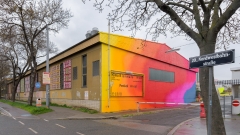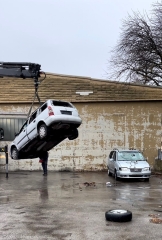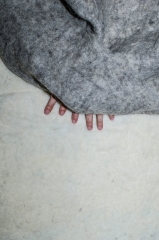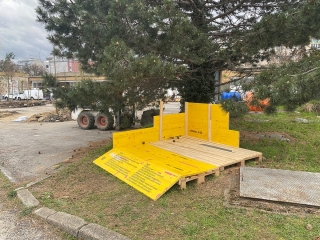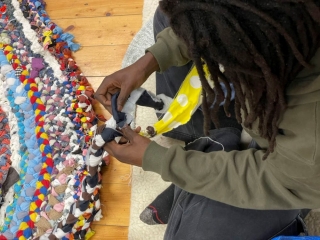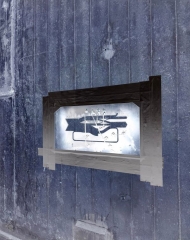09. April 2024
The Klima Biennale Wien
lasts 100 days. With 10 days of intensive program, the Biennale starts into its first edition and positions the city of Vienna
as a pioneer in combining current ecological challenges with art, design, architecture and science. The public program includes
numerous events, workshops and guided tours.
Angewandte is the official program partner of the Klima Biennale
Wien with the exhibition Solutions & Strategies. The exhibition is a cooperative series of the University of Applied
Arts Vienna and the Academy of Fine Arts. Some of the projects have been started in the winter semester of 2023 and will be
implemented during the Biennale period. Students, professors and alumni:ae of the participating classes will have the opportunity
to realize their own projects during this time.
The following projects developed at the
Angewandte are represented at the Klima Biennale Wien as part of Solutions & Strategies:
These Tires are Made for Walking-TransArts – Transdisciplinary Art
Project management:
Markus Hiesleitner
The windows smashed, the tires stabbed: this is how the two discarded cars were found on
the grounds of the Nordwestbahnhof. In the context of the Klima Biennale, they form the basic structure for the group presentation
of the department of TransArts at the Angewandte. Automobility polarizes and emotionalizes like hardly anything else in the
climate debate, which is also fought out on the streets, in traffic, i.e. directly between cars. For the students, the car
wrecks serve as a projection screen for thoughts about mobility, adaptability and mental flexibility in times of climate change.
The students worked on site, developing new approaches and adapting existing ones. In a collective process, they engaged
with the car wrecks, which they transformed into their exhibition display.
With these tires are made for walking,
the students question an "urban understanding of nature" in a technologized and digitalized environment. Installative interventions
transform the two car wrecks into carriers for new works and ideas.
The ten positions are distributed in, on and around
the cars. Weather, flora and fauna are explored, as well as the acoustic and olfactory impressions of a city.
Schlafende
Hunde ("Sleeping dogs") – Site Specific Art
Project management: Paul Petritsch
Curator: Marlies Pöschl
What
if the so-called dogs went on strike by not waking up from their sleep? The labor of non-human animals is exploited in many
ways in contemporary biocapitalism, mostly without being understood as being labor. This concerns not only their actual productive
power, but also the reproductive abilities of (female) animals: Animals become meat, milk becomes food. Non-human animals
also often contribute to shaping the environment without this being perceived as work. The cultural and material logistics
established by humans have been producing and using animal life as a form of capital for centuries.
The works presented
in this exhibition by graduates of the Department of Site Specific Art (University of Applied Arts) are dedicated to this
unequal division of labor between human and non-human animals. It introduces the motif of sleep as a subversive strategy.
Sleep can take many forms: Rest, hibernation, breeding phase. The works shown here thus pose the question of the extent to
which animals and humans can resist these forms of exploitation by consciously taking breaks. But they also address the fact
that it may be too late to wake the dogs: that human trust in the regenerative processes of nature is out of any proportion
to the consequences of systematic destruction.
Compost Group: Compost Care – Klasse
für Alle
Project management: Andrea Lumplecker
In the words of Donna Haraway, "We are
humus, not Homo, not anthropos; we are compost, not posthuman.". The Compost Group of Klasse für Alle takes on compost
in both an organic and metaphorical sense. Composting is understood as a ritual of collecting, recognizing and transforming
and becomes a metaphor for all life processes. Seeing and recognizing nutrient cycles and giving meaning and dignity to everyday
waste through composting practices such as moving, writing, (deep) listening, sound creation and care.
The Klasse für
Alle's Compost Group takes on compost in both an organic and metaphorical sense. Composting is understood as a ritual of collecting,
recognizing and transforming and becomes a metaphor for all life processes.
Common Ground Group – Klasse für
Alle
Project management: John Paul Ayodo, Ingrid Garschall, Marieluisa Lenglachner, Johanna Preissler,
Carina Riedl, Paul Röttger, Elisabeth Smejkal, Dominika Svarc, Barbara Ziegelböck
A large carpet is created
through the joint work of many people. Each person leaves behind a braid that becomes part of the carpet and thus leaves a
trace in it. The time spent together creates space for exchange and conversation. The handicraft technique is simple and can
be used immediately. Discarded and trashed items are transformed into an object that offers space for everyone to enter into
dialog, listen and learn from each other.
Further information at: https://www.biennale.wien/ausstellungen/solutions-strategies
More
contributions by the Angewandte to the Klima Biennale Wien:
Reverse Imagining Vienna-an exhibition of the AIL
– Angewandte Interdisciplinary Lab
Opening: 30.4.2024, 7 pm
https://ail.angewandte.at/program/riv
Exactly
as Imagined-a temporary collective of students and artists from the Department of Site-Specific Art/University of Applied
Arts Vienna in cooperation with brut Wien
Opening: 1.6.2024, 6 pm
https://brut-wien.at/de/Programm/Kalender/Programm-2024/06/Ausstellung-Exactly-as-Imagined




